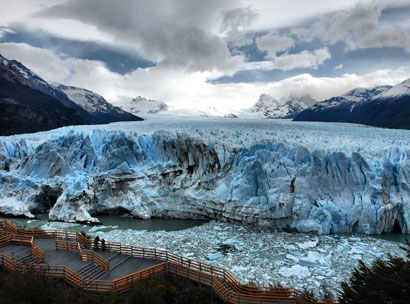Argentina
Country statistics

Land area: 1,056,636 sq miles (2,736,690 sq km)
Total area: 1,068,302 sq miles (2,766,890 sq km)
Population (2010 est.): 41,343,201 (growth rate: 1.0%); birth rate: 17.7/1000; infant mortality rate: 11.1/1000; life expectancy: 76.7; density per sq miles: 38
Capital City: Buenos Aires
Monetary unit: Peso
Languages: Spanish (official), English, Italian, German, French
Ethnicity/race: White: white (mostly Spanish and Italian) 97%; mestizo, Amerindian, other 3%
Religions: Roman Catholic 92%, Protestant 2%, Jewish 2%, other 4%
Country introduction

Argentina is a country in South America, bordered by Chile to the west and south, Bolivia and Paraguay to the north, and Brazil and Uruguay to the north-east. Argentina claims sovereignty over part of Antarctica, the Falkland Islands, and South Georgia and the South Sandwich Islands.
Argentina contains a number of very distinct features and unique regions. It offers every variety of climate and landscape: from tropical heat, always rainy and full of colorful vegetation, to polar cold, with its soberly white look thanks to snow and ice.
North of Buenos Aires, the Iguazu Falls is one of the greatest wonders of nature in the world. Further south, one can find the unbelievable region of Patagonia. featuring amazing mountains and lakes. El Calafate and Peninsula Valdes feature wonders like the Perito Moreno Glacier along with amazing nature and wildlife, while Tierra del Fuego is the closest point to the Antarctic. Here penguin colonies, glaciers and an encounter of a great variety of wildlife can experienced.
Argentina leads the market of sun seed oil, soy oil, horses, jojoba, lemons, honey, corn, soybean, beef cattle, wine, and hidroboracita.
The culture

The culture of Argentina is as varied as the country's geography and is composed of a mix of ethnic groups. Modern Argentine culture has been largely influenced by European immigration, although there are lesser elements of Amerindian and African influences, particularly in the fields of music and art.
More than one-third of the country's 32 million people live in Buenos Aires, the capital, which along with other urban areas accounts for almost 90% of the total population. The main indigenous peoples are the Quechua of the north-west and the Mapuche in Patagonia. Others can be found in the Chaco and the north-east. There are strong Jewish and Anglo-Argentine communities throughout the country, including Japanese, Chileans and Bolivians, and pockets of Paraguayan and Uruguayan residents.
The universal language of Argentina is Spanish, but many natives and immigrants keep their mother tongues as a matter of pride. In Buenos Aires a city slang called lunfardo is used. Argentina has religious freedom, although the official religion is Roman Catholic.
All over Argentina fine handicrafts can be found. The gauchos produce silver buckled belts, spurs, stirrups and the mate gourds from which they drink their mate through a silver straw. The indigenous groups produce wood carvings, weavings and textiles such as ponchos.
Argentina is one of the few South American countries with a thriving cinema and TV industry. Since the end of dictatorship and military rule the arts have flourished. Tango is the quintessential music and dance of Argentina, but other folkloric traditions persist. There is even a home-grown rock music industry. The Teatro Colon in Buenos Aires is reputed to be one of the best and most outstanding theatres in the world.
One cannot omit the national obsession with football but motor racing and polo also form part of the national psyche.
The main holiday period is January to March (when the schools are closed). Easter and July are also busy times. The 10 November Dia de La Tradicion are like a gaucho games, with displays, music, and plenty of asado meat.
Attractions & landmarks

Argentina is the world's eighth largest country that encompasses a staggering diversity of landscapes, ranging from the hot and humid jungles of the north-east and the bone-dry highland steppes of the north-west, via the fertile, low-land Pampas and windswept Patagonia, to the end-of-the-world archipelago of Tierra del Fuego in the south.
Buenos Aires, one of the most fascinating of all Latin American capitals, is an amazing city with a lot of class and culture. It's an immensely enjoyable place to wander about, to watch people, to shop or simply to soak up the unique atmosphere. Its many neighbourhoods are startlingly different, some are decadently old-fashioned, others modern, but all of them exude character.
The Pantagonia Desert that lies in the far south is a vast, ice-cold expanse of windswept rocks that makes it an adventure traveler's paradise. Argentina's Southern Andes peaks and Pantagonian glaciers have snow all the year round. Here visitors can watch sea life on the Atlantic coast, scuba dive in Puerto Madryn, dig for fossils in Neuquen, scale mountains in El Chaltén, ski and snowboard in Bariloche, San Martin de los Andes, El Calafate and Ushuaia.
Among its many staggering landscapes, Argentina has one of the greatest natural wonders, the Iguazu Falls. The falls have 275 individual cascades, with the highest fall dropping almost 82 m (270 ft). Another natural wonder that can be visited is the Perito Moreno glacier and the Tierra del Fuego, which is considered to be the closest point to the Antarctic. In fact, many travelers that have been here have considered this to be the closest to get to the Antarctic without having to even go there.